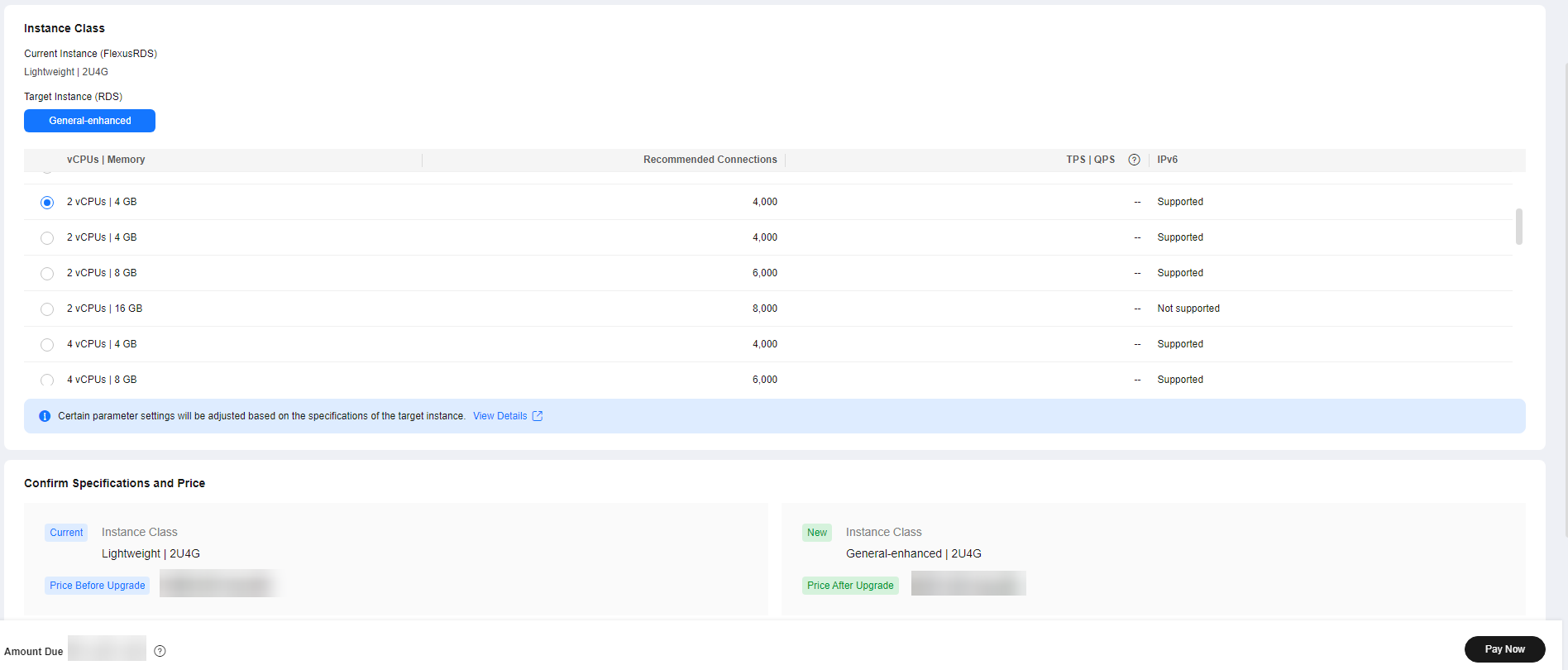Upgrading a FlexusRDS for MySQL Instance to an RDS DB Instance
Scenarios
You can change a FlexusRDS for MySQL instance to an RDS DB instance to experience more functions. For comparison between FlexusRDS for MySQL and RDS DB instances, see FlexusRDS Overview.
Constraints
- Your account balance must be no less than $0 USD.
- When a FlexusRDS for MySQL instance is being upgraded to an RDS instance, the following operations cannot be performed on the instance: deleting the instance, rebooting the instance, modifying the parameter template, or creating backups.
- If there is any large transaction being performed during the upgrade, the upgrade may fail.
- The upgrade takes 5 to 15 minutes (during off-peak hours). If it takes an extended period of time, contact customer service.
- The instance will be rebooted and services may be interrupted during the upgrade. The length of the interruption depends on the workloads and how much data there is. Upgrade your instance during off-peak hours.
Parameter Changes
|
Scenario |
Rule for a Parameter with No Changes Made to Its Value |
Rule for a Parameter Changed to a Custom Value |
|---|---|---|
|
vCPU increase |
The parameter will be reset to the default value of the new instance class. |
The larger one between the custom value and the default value of the new instance class will be used. |
|
vCPU decrease |
The parameter will be reset to the default value of the new instance class. |
The smaller one between the custom value and the default value of the new instance class will be used. |
Memory-related parameters, such as innodb_buffer_pool_size, innodb_log_buffer_size, innodb_log_files_in_group, max_connections, innodb_page_cleaners, innodb_buffer_pool_instances, and back_log, will be reset according to the following rules.
|
Scenario |
Rule for a Parameter with No Changes Made to Its Value |
Rule for a Parameter Changed to a Custom Value |
|---|---|---|
|
Memory increase |
The parameter will be reset to the default value of the new instance class. |
The larger one between the custom value and the default value of the new instance class will be used. |
|
Memory decrease |
The parameter will be reset to the default value of the new instance class. |
The smaller one between the custom value and the default value of the new instance class will be used. |
However, values of innodb_io_capacity and innodb_io_capacity_max will be reset to the default values of the new instance class if no custom values have been specified for them or they will remain unchanged if you have specified custom values for them.
Procedure
- In the instance list, locate the target instance and click Upgrade to RDS in the Operation column.
- On the displayed page, select the target RDS instance class.
Figure 1 Upgrading to RDS

- After confirming the configuration, click Pay Now and complete the payment as prompted.
During the upgrade, the instance status is Upgrading to RDS.... After the upgrade is complete, the instance status changes to Available.
- To manage the RDS instance, click
 in the upper left corner of the page and choose Databases > Relational Database Service. On the Instances page, search for the instance by its name.
in the upper left corner of the page and choose Databases > Relational Database Service. On the Instances page, search for the instance by its name.

The RDS instance name and ID are the same as those of the FlexusRDS for MySQL instance before the upgrade.
Feedback
Was this page helpful?
Provide feedbackThank you very much for your feedback. We will continue working to improve the documentation.See the reply and handling status in My Cloud VOC.
For any further questions, feel free to contact us through the chatbot.
Chatbot





